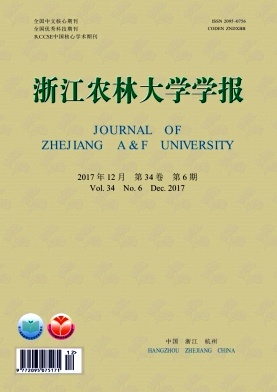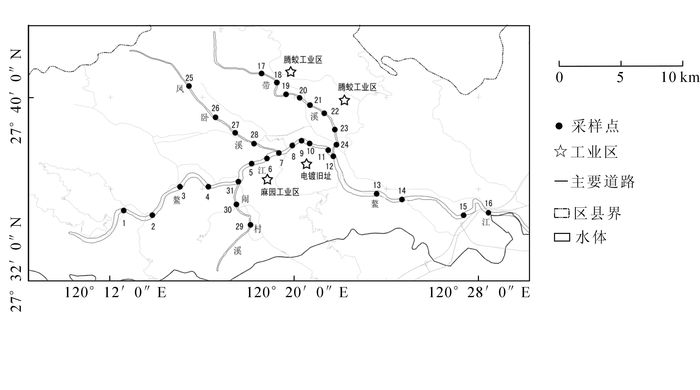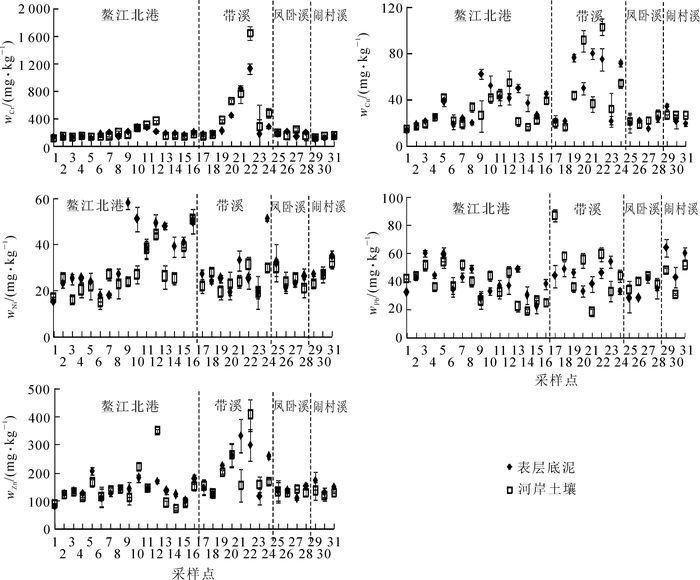-
河流的重金属含量是河流的重要参考指标,与河流健康密切相关[1-2]。自然情况下,河流的重金属含量通常很低。工业排放的重金属会严重污染河流岸边土壤及河床表层底泥,威胁河流环境健康[3]。与其他的污染不同,重金属作为一类非降解性有毒有害物质,容易在水环境的沉积物中吸附和积累[4]。同时,排放到水环境中的重金属又很容易通过物质循环进入食物链,最终进入人体造成严重危害[5]。20世纪50年代日本发生的水俣病和骨痛病等公害病,20世纪70年代中国陕西发现的华县癌症村,均因重金属污染引起[6-8]。早在20世纪70年代,欧美等发达国家就开始对河流重金属污染开展研究,如塞纳河[9]、多瑙河[10]、莱茵河[11]等,迄今为止几乎包括了所有重要河流。其中CASTILLO等[12]对西班牙Andalucfa地区水体及底泥中的重金属生物有效性进行了分析,发现20世纪以来工业发展对该地区水体及底泥造成严重污染,尤其是铜、镍、铅污染最为严重。近年来,国内学者对河流、湖泊及水库的河岸土壤及表层底泥重金属污染展开大量研究[13-17]。其中,周立旻等[18]对苏州河上海段底泥重金属污染特征进行了分析,发现元素铜、铅、锌、铬等是主要产生生态危害的重金属元素,底泥重金属富集程度与沿岸的工业化发展进程密切相关。在浙江沿海的温州鳌江流域,工业生产和社会经济迅速发展,河流水环境重金属污染不断加重,给生态环境和人体健康带来了极大威胁[19-20]。2015年浙江省制定《浙江省重金属污染综合防治方案》,温州市平阳县被列为国家级重金属重点防控区,但截至目前尚未有人对该区鳌江流域的重金属开展研究。本研究拟以鳌江北港段为对象,研究河流表层底泥与河岸土壤中的重金属分布,并对潜在生态风险进行评价,以期为水环境治理和管理提供科学依据。
HTML
-
鳌江流域是浙江省八大水系之一,位于浙江省温州市境内,是全国三大涌潮江之一,干流全长82.47 km。研究区域为流经平阳县内的鳌江干流和闹村溪、带溪、凤卧溪等3条支流。制革印染是当地主要产业,也是亚洲最大的加工地。制革大量使用含铬鞣剂和含高浓度三价铬盐[21];皮革染色常用铜盐(酒石酸铜钠、硫酸铜、醋酸铜)和铬盐作为染色的固色剂[22]。制革印染产生的废水约占全县废水总量的70%,污染物排放总量约为84 500 t·a-1[19];2015年温州市环境质量公报显示,鳌江流域为中度污染,已对该流域附近的居民生产生活用水产生极大影响[23]。
-
底泥样本采集于2016年3月,在干流和3条支流的拐弯处、堤坝、桥梁、河(溪)口等河道底泥淤积严重的断面设置采样点31个[24],共采集断面表层底泥和河岸土壤样品31组(图 1)。用重力式柱状沉积物采样器采集水下0~20 cm处底泥,样品采集后装入聚四氟乙烯自封袋中;用ETC-300A手动土壤采样器采集河岸0.3~2.0 m处0~20 cm土壤,样品采集后同样装入聚四氟乙烯自封袋中[25]。记录取样点位置、编号和周围环境等信息(表 1)。风干采集样品,去除植物残体和石砾,用玛瑙棒研压,过100目尼龙筛后备用;使用X-MET 7000射线荧光光谱仪(精度为1 mg·kg-1)[26]测量铬、镍、铜、锌、铅的质量分数。采用国家标准物质《土壤成分分析标准物质——暗棕壤》(GSS-1)和《水系沉积物标准物质》(GSD-12)进行控制。测量结果表明:GSS-1和GSD-12标准样品中重金属元素实测值与参考值的相对标准偏差(RSD)均小于10%。
编号 河段 采样点 主要污染源 1 鳌江北港 顺溪镇 无明显污染源 2 前山村 无明显污染源 3 溪南山路 无明显污染源 4 雁荡山景区 无明显污染源 5 浦潭村水坝 生活垃圾堆放严重 6 龙涵村桥 制革印染综合厂区的污水排放,生活垃圾倾倒严重 7 麻园桥 制革印染综合厂区的污水排放,生活垃圾倾倒严重 8 麻园村 制革印染综合厂区的污水排放,生活垃圾倾倒严重 9 清溪村 制革印染综合厂区的污水排放,生活垃圾倾倒严重 10 下小南村 废旧电镀厂附近,生活垃圾倾倒严重 11 青岙村 废旧电镀厂附近,生活垃圾倾倒严重 12 显桥 河口淤积大量污泥 13 下堡村 河口淤积大量污泥 14 麻布桥 河口淤积大量污泥 15 桃源大桥 河口淤积大量污泥 16 岱口大桥 河口淤积大量污泥 17 带溪 湖窦村 无明显污染源 18 腾龙路 河口淤积大量污泥,周围有生活垃圾倾倒 19 铜牌厂 电镀,制革印染综合厂区的污水排放 20 工业一区 制革印染综合厂区的污水排放 21 工业二区 制革印染综合厂区的污水排放 22 腾蚊桥 制革印染综合厂区的污水排放 23 溪尾大桥 河口淤积大量污泥,周围有大量生活垃圾倾倒 24 高桥村 河口淤积大量污泥,周围有大量生 25 凤卧溪 凤卧镇 无明显污染源 26 凤安村 无明显污染源 27 工业区 制革印染综合厂区的污水排放 28 凤卧废弃桥 桥梁处淤积大量污泥 29 闹村溪 中村 无明显污染源 30 闹村乡 无明显污染源 31 闹村溪口 车流量大 Table 1. Location of sampling sites and the surroundings
-
用SPSS 19.0及GraphPad Prism 5.0进行数据分析,采样点分布图在Arc GIS 10.2软件中处理与输出。重金属质量分数与背景值的差异性分析采用单样本T检验法;不同介质的重金属质量分数差异性采用独立样本t检验法;数据正态分布检验采用K-S检验(P>0.05,样本呈正态分布),对符合正态分布的数据进行相关分析和Hakanson潜在生态风险评价[27]。具体公式如下:
式中:Cfi为某污染因子;Ci为表层沉积物中某重金属的实测值;Cni为计算所需的参比值;Tri为沉积物中某污染物的毒性响应系数,5种重金属铬、铜、锌、镍、铅的毒性响应系数分别为2,5,1,5,5[20]。Eri为某单个污染物的潜在生态风险指数。对应的污染级别可分为:Eri<40属于轻微生态危害;40≤Eri<80属于中等生态危害;80≤Eri<160属于强生态危害;160≤Eri<320属于很强生态危害;Eri≥320属于极强生态危害。IR为多种重金属综合潜在生态风险指数。对应的污染级别可分为IR<150属于轻微生态风险;150≤IR<300属于中等生态风险;300≤IR<600属于强生态风险;600≤IR<1 200属于很强生态风险;IR≥1 200属于极强生态风险。
1.1. 区域概况
1.2. 样品采集与分析
1.3. 数据分析与处理
-
如表 2所示:表层底泥和河岸土壤中的铬、镍、铜、锌质量分数均显著高于温州市土壤重金属背景值[28],而铅基本持平。实地调查资料显示(表 1):河流表层底泥污染来自于河水污染沉淀,岸边土壤污染则是因为涌潮及河水回流抬升产生的“二次污染”[29],因此,表层底泥与河岸土壤中重金属质量分数差异极小。
介质 w重金属/(mg.kg-1) 铬 镍 铜 锌 铅 表层底泥 233 ± 38 a* 32 ± 2 a* 36 ± 4 a* 159 ± 11 a* 43 ± 2 a 河岸土壤 274 ± 54 a* 26 ± 1 b* 33 ± 4 a* 157 ± 15 a* 41 ± 3 a 温州市土壤重金属背景值[23] 52 22 20 111 41 说明: *表示表层底泥或河岸土壤中的重金属质量分数显著高于温州市土壤重金属背景值。不同小写字母表示表层底泥与河岸土壤之间差异显著(P<0.05),相同字母表示差异不显著(P>0.05)。 Table 2. Concentration of heavy metals in surface sediments and riparian soil
-
对鳌江北港段表层底泥5种重金属离子相关性分析表明(表 3),表层底泥铬—铜、铬—锌、铜—锌的相关系数均达到极显著水平(P<0.01),铜—镍的相关系数达到显著水平(P<0.05),铅与其他元素间为无明显关系或负相关。河岸土壤中铬—铜、铬—锌、铜—锌的相关系数也均达到极显著水平(P<0.01),铅与其他各元素之间无明显相关性。底泥表层与岸边土壤中的重金属离子的相关性特征一致,表征两者的污染过程和强度基本一同。
金属 表层底泥 河岸土壤 铬 镍 铜 锌 铅 铬 镍 铜 锌 铅 铬 1 1 镍 一0.016 1 0.129 1 铜 0.666** 0.433* 1 0.841** 0.251 1 锌 0.781** 0.104 0.831** 1 0.688** 0.340 0.800** 1 铅 一0.122 一0.183 一0.102 0.020 1 0.132 一0.165 0.212 0.345 1 说明:**和*分别表示P<0.01极显著和P<0.05显著。土壤样本数n=31;沉积物样本数n=31。 Table 3. Correlation matrix of heavy metals in surface sediments and riparian soil
富集程度较高的样点主要分布在鳌江北港段和带溪,有574.37万t·a-1制革印染污水排放,占全县废水总量的52.63%[19]。这与付传城等[30]对南京市柘塘镇土壤重金属研究结果相同,重金属污染主要来自当地工业排放。表层底泥中铜和镍的相关性主要来自电镀企业[31-32]。铅平均质量分数与背景值差异不显著,主要来源成土母质。
-
如图 2所示:铬在整个流域范围内鳌江北港7~12号和带溪19~22,24号采样点呈现高值区;镍只在鳌江北港9~16号的底泥呈现高值区;铜在鳌江北港5,9~12号和带溪19~22,24号采样点呈现高值区;锌在鳌江北港9~12号和带溪19~22,24号采样点呈现高值区;铅除17号点外,其他样点质量分数变化不明显。总的来看,这5种重金属质量分数较大值主要出现在鳌江北港段的9~12,16号和带溪的19~22,24号采样点。此外,发现流域2种介质中铬、铜、锌变化趋势基本一致,鳌江北港段表层底泥的镍与铜变化趋势较为一致,2组变化趋势的一致性与上文的相关性分析结果对应。
部分采样点表层底泥和河岸土壤重金属富集程度较高,可能是生活垃圾堆放和工业排放等人为干扰因素造成的。尚小娟等[33]研究表明:垃圾中重金属因自由降水的淋溶,溶解释放到河岸土壤和河底底泥中,会导致其中的铬、镍和铜富集。根据表 1实际情况看,鳌江北港的5~12号采样点生活垃圾堆放是铬、镍和铜富集程度较高主要原因之一。FAHIM等[34]研究表明:铬主要来源于制革印染工业区大量排放的废水。根据表 1记录,鳌江北港的6~9号,带溪的20~22号采样点的周围是麻园工业区和腾蛟工业区,该工业区以制革印染业为主,解释了这些样点铬富集程度较高的原因。李萍等[22]对制革印染工业流程的研究表明:铜和锌来源于制革、印染企业生产过程中使用的染料和助剂,镍并非来自企业生产环节,而是一些印染企业废水处理过程中使用废酸所致,有些废酸源于电镀、镀锌等企业,里面含有包括铜、锌和镍在内的多种重金属杂质。因此鳌江北港段的大部分采样点铜、锌和镍富集程度较高,主要是制革印染业排放引起的。带溪17号采样点的河岸土壤铅质量分数较高,可能原因是该地的地壳和岩石铅本底值较高,采样周围未发现污染源。
-
采用Hakanson潜在生态风险评价法,以温州市土壤背景值为参照值对鳌江流域表层底泥中重金属的潜在生态危害进行评估,结果见表 4。从单一重金属来看,鳌江流域表层底泥的重金属铬、镍、铜、锌和铅的各河段的生态风险指数(Eri)均小于40,属轻微污染;从多种重金属综合情况来看,各河段的表层底泥中多种重金属的综合潜在生态风险指数(IR)均小于150,属轻微污染。总的来看,表层底泥5种重金属潜在生态风险指数(Eri)从大到小依次为铬>铜>铅>镍>锌;各河段底泥重金属综合潜在生态风险系数(IR)从大到小依次为带溪>鳌江北>闹村溪>凤卧溪。
河段 Eri IR 铬 镍 铜 锌 铅 鳌江北港段 6.21 7.51 7.34 1.65 5.77 28.47 带溪 15.19 5.83 11.48 2.63 6.29 41.42 凤卧溪 6.35 5.33 4.42 1.58 4.66 22.34 闹村溪 5.43 7.74 5.97 1.78 6.54 27.46 平均值 8.30 6.60 7.30 1.91 5.82 29.92 Table 4. Potential ecological risk coefficient (Eri) and potential ecology risk index (IR) of heavy metals in surface sediments from the the Aojiang river
-
采用Hakanson潜在生态风险评价法,以温州市土壤背景值为参照值对鳌江流域河岸土壤中重金属的潜在生态风险进行评估,结果见表 5。从单一重金属潜在生态风险指数(Eri)来看,鳌江流域河岸土壤的重金属铬、镍、铜、锌和铅的各河段Eri也均小于40,属轻微污染;从多种重金属综合潜在生态风险指数(IR)来看,各河段的河岸IR均小于150,属轻微污染。总的来看,河岸土壤中5种重金属潜在生态风险指数(Eri)从大到小依次为铬>铜>镍>铅>锌;各河段底泥重金属综合潜在生态风险指数(IR)从大到小依次为带溪>鳌江北港段>闹村溪>凤卧溪。
河段 Eri IR 铬 镍 铜 锌 铅 鳌江北港段 6.34 5.74 6.29 1.76 5.23 25.36 带溪 19.97 5.13 10.92 2.44 6.83 45.29 凤卧溪 6.64 5.23 4.87 1.59 5.46 23.79 闹村溪 7.74 7.18 7.89 2.78 6.02 31.62 平均值 10.17 5.82 7.49 2.14 5.89 31.52 Table 5. Potential ecological risk coefficient (Eri) and potential ecology risk index (IR) of heavy metals in sriparian soil from the of the Aojiang river
2.1. 表层底泥与河岸土壤重金属特征
2.2. 重金属元素的相关性分析
2.3. 表层底泥和河岸土壤重金属质量分数空间分布与潜在生态风险评价
2.3.1. 表层底泥和河岸土壤重金属质量分数空间分布
2.3.2. 表层底泥重金属潜在生态风险评价
2.3.3. 河岸土壤重金属潜在生态风险评价
-
统计特征分析表明:除铅外,其他重金属质量分数均显著高于温州市土壤背景值,表层底泥中镍的质量分数显著高于河岸土壤。鳌江流域表层底泥与河岸土壤铬、铜和锌质量分数表现极显著相关性,主要受制革印染业影响,涌潮河水回流抬升对岸边土壤产生二次污染;表层底泥镍与铜具有较强的相关性,主要受电镀业影响;铅与其他元素均无显著相关性,主要来自成土母质。流域铬、铜和锌重金属主要富集在鳌江北港段和带溪段,镍的富集主要在鳌江北港段,富集现象主要由于人为干扰;流域整体表层底泥及河岸土壤5种重金属单一潜在生态风险指数(Eri)均小于40,属轻微污染;2处的5种重金属综合潜在生态风险指数(IR)均小于150,也属轻度污染。其中铬的潜在生态风险最大,带溪的重金属综合潜在生态风险指数(IR)最大,应当开展针对性清理。









 DownLoad:
DownLoad:
